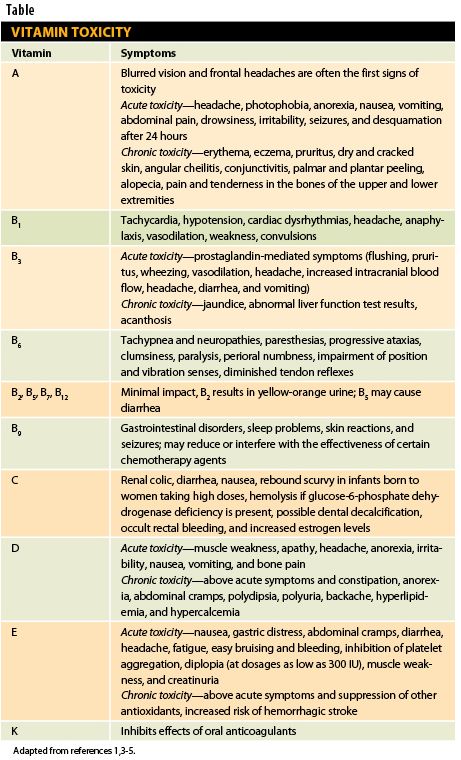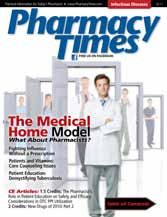Publication
Article
Pharmacy Times
Patients and Vitamins: Core Counseling Issues
Author(s):
Pharmacists should query patients about their vitamin intake to help identify deficiencies, assess potential interactions, and avoid toxicity.
Pharmacists should query patients about their vitamin intake to help identify deficiencies, assess potential interactions, and avoid toxicity.
The popular media draws attention to the benefits of vitamins for consumers. Their grocery shopping only reinforces vitamins’ importance—many juices, cereals, and canned goods have labels prominently stating that their contents are fortified with any number of vitamins and minerals. In fact, the marketing works— up to 44% of Americans take daily vitamin and dietary supplements and as many as 84% consider them to be safe.1
Vitamin Basics
Humans need 13 vitamins: vitamins A, C, D, E, K, and the B vitamins—B1 (thiamine), B2 (riboflavin), B3 (niacin), B5 (pantothenic acid), B6 (pyridoxine) B7 (biotin), B9 (folate), and B12 (cyanocobalamin). 2,3 Recommended daily allowances vary by age and gender; reference tables can be downloaded at the Department of Agriculture’s Food and Nutrition Information Center (http:// fnic.nal.usda.gov). Lifestyle also affects daily nutrient needs. Smokers, for example, require 35 mg more of vitamin C than nonsmokers.3
Too Much of a Good Thing
Most patients know vitamin deficiency results in problems, but few ponder the problems caused by vitamin toxicity. Annually, approximately 60,000 people ingest toxic amounts of vitamins. Approximately 75% of these cases involve children who apparently mistake vitamins for candy.1 Although these cases are rarely fatal, they are associated with various adverse effects (Table13-5).

Focus on Vitamin D
Every so often, an individual vitamin takes center stage. First it was vitamin C, and then it was vitamin E along with other antioxidants. Today, on center stage is vitamin D because of its importance in bone health. Strong bones require calcium as well as vitamin D, which is needed for calcium absorption. Most people consume adequate calcium, but people who live in northern climates or are housebound have increased risk for deficiency. Vitamin D deficiency results in inadequate skeletal mineralization, leading to decreased bone density and increased fracture risk.6 The Institute of Medicine does not recommend routine vitamin D and calcium supplements; most people obtain adequate levels though diet and natural sunshine. Supplements, however, are recommended for people with deficiencies.
Counseling Issues
Most pharmacists do not routinely query patients on vitamin supplements. In fact, they should. There are many issues to discuss that provide opportunities for pharmacists to offer counseling. For example, vitamin K and vitamin E negatively impact anticoagulation therapy, and antioxidants such as vitamins C and E reduce the effectiveness of certain cancer chemotherapies.7 Many drugs impact vitamin D metabolism. Antiepileptic medications (phenytoin, fosphenytoin, phenobarbital, and carbamazepine) can increase vitamin D’s metabolism. Other medications—cholestyramine, colestipol, orlistat, mineral oil, and ketoconazole— reduce its absorption or interfere with its metabolism.6
Many patients wonder if they need vitamin supplements at all. Pharmacists should inform patients that the best way to meet nutrient needs is by consuming appropriate foods and that vitamin supplementation is only suggested for:
• Individuals consuming fewer than 1600 calories per day
• Vegans, vegetarians, and anyone eliminating an entire food group from their diet
• Pregnant and breast-feeding women
• Postmenopausal women and women with heavy menstruation
• Individuals with chronic diarrhea, food allergies, and food intolerance
• Individuals who have had surgical removal of portions of their digestive tract or bariatric bypass surgery4,8
You need to know vitamin deficiency signs: fatigue, pale or yellowish skin tone, sore mouth and tongue, weight loss, diarrhea, tingling or numbness in hands and feet, muscle weakness, irritability, unsteady movements, confusion, and forgetfulness. 4 Despite America’s expanding waistline, many individuals consume inadequate amounts of vitamins A, B9, B12, C, and E.2 Pharmacists may highlight this along with foods with high nutrient levels (Table 2). Emphasize that too much of a vitamin can be just as bad as too little of a vitamin. Vitamins should always be stored in a dry cool place and never in direct sunlight.
Table 2. Rich Food Sources for Vitamin A, B9, B12, C, E
A
B9
B12
C
E
Liver
Chicken
Carrots
Milk
Fruits
Spinach
Kale
Citrus fruits and juices
Dark leafy green vegetables
Enriched grain products
Dried beans and peas
Red meats
Poultry
Shell fish
Dairy products (eggs, milk, cheese, yogurt)
Citrus fruits and juice
Tomatoes
Sweet peppers
Cantaloupe
Broccoli
Nuts and grains
Spinach
Broccoli
Green leafy vegetables
Peanut butter
Tomatoes
Adapted from references 4 and 9.
Patients should ask for their doctors’ approval before taking supplements. Also, a multivitamin meets most people’s needs. Patients should avoid taking doses of individual vitamins; it increases the risk for vitamin toxicity. Some may query about megavitamin therapy or orthomolecular medicine—treatment employing megadoses of vitamins. Megavitamin therapy lacks scientific evidence and carries its own risks for vitamin toxicity.9
Pharmacists should counsel patients that too much calcium leads to kidney stones and excessive vitamin D can damage the heart and kidneys. For insistent patients, emphasize that 1000 mg of calcium meets most people’s needs. Older adults require 1200 mg. With so many fortified foods, patients need to be vigilant about consuming too much calcium. Depending on age and gender, calcium’s upper intake level for adults ranges from 2000 to 3000 mg. For most adults, 600 IU of vitamin D meets their needs; older adults require approximately 800 IU. Upper intake level for vitamin D is 4000 IU.10
Final Thought
Pharmacists and their patients can find an abundance of additional useful information, including FAQs, at the National Institute of Health’s Office of Dietary Supplements at http://ods.od.nih.gov/.
Dr Zanni is a psychologist and health systems consultant based in Alexandria, Virginia.
References
1. Rosenbloom M. Toxicity, vitamin. http://emedicine.medscape.com/article/819426-overview. Accessed November 30, 2010.
2. U.S. Food and Drug Administration. Fortify your knowledge about vitamins. www.fda.gov/forconsumers/consumerupdates/ucm118079.htm. Accessed November 30, 2010.
3. WebMD. Pantothenic acid (vitamin B-5). www.webmd.com. Accessed January 6, 2011.
4. Mayo Clinic Staff. Vitamin deficiency anemia. www.mayoclinic.com/health/vitamin-deficiency-anemia/DS00325. Accessed No vember 30, 2010.
5. MedlinePlus. Multiple vitamin overdose.www.nlm.nih.gov/medlineplus/ency/article/002596.htm. Accessed November 30, 2010.
6. Stokowski L. Vitamin D in the older adult. www.medscape.com/viewarticle/733968. Accessed December 22, 2010.
7. Dietary supplements: what you need to know.
8. Mayo Clinic Staff. Dietary supplements: nutrition in a pill? www.mayoclinic.com/health/supplements/NU00198. Accessed November 30, 2010.
9. American Academy of Pediatrics. Vitamin supplements and children. www.healthychildren.org/English/ages-stages/gradeschool/nutrition/pages/Vitamin-Supplements-and-Children.aspx?nfstatus=401&nftoken=00000000-0000-0000-0000-000000000000&nfstatusdescription=ERROR%3a No local token. Accessed November 30, 2010.
10. Institute of Medicine. Dietary reference intakes for calcium and vitamin D. www.iom.edu/~/media/Files/Report%20Files/2010/Dietary-Reference-Intakes-for-Calcium-and-Vitamin-D/Vitamin%20D%20and%20Calcium%202010%20Report%20Brief.pdf. Accessed December 24, 2010.
11. Office of Dietary Supplements, National Institutes of Health. Vitamin E. http://ods.od.nih.gov/factsheets/vitamine. Accessed January 4, 2011.







